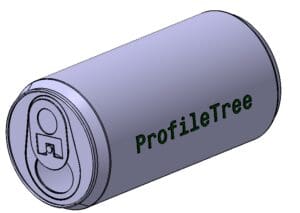CATIA (Computer-Aided Three-Dimensional Interactive Application) is a powerful and versatile computer-aided design (CAD) and computer-aided engineering (CAE) software suite. CATIA software is renowned for its extensive array of unique features and functionalities catering to various design and engineering needs.
The French company Dassault Systèmes developed the software, and it’s widely used in several industries, which makes it an indispensable resource for professionals in various fields. These industries include aerospace, automotive, manufacturing, and engineering for product design, modelling, simulation, and various other tasks related to product development.
This versatile software package empowers users with a diverse toolkit encompassing part modelling, assembly modelling, surface modelling, finite element analysis, sheet metal part design, rendering, and engineering drawing creation.
Walk with us through this comprehensive guide to the intricacies of this potent software.
Table of Contents
Key Features of CATIA Software
CATIA is known for its robust 3D modelling capabilities and comprehensive tools that enable designers, engineers, and other professionals to create, visualise, and analyse complex 3D models of products and systems. Here are some of the key features and functionalities of the software:
Part Modelling

Part Modeling is an excellent tool in CATIA software. It helps you create very detailed and exact 3D models. This feature is perfect for mechanical engineers, who can use it to examine parts of their product’s quality and performance while they make it.
Are you making moulded parts? Then, we recommend using CATIA V5-6R. It has unique features made just for this kind of work, but be careful! For the best results with CATIA, your tech must meet specific needs.
This will let CATIA work at its best and help you design amazing things. Many industries, like car or plane manufacturing, also find part modelling really helpful in their work.
Assembly Modelling
Assembly modelling is another significant feature of CATIA. It lets you make complex designs from small parts. You can see your design as if it were real. This makes it easy to spot any issues and fix them on the spot.
You can also make models for things like fluid systems and electronic systems. Not all software offers this, but CATIA does. Designing these things in 3D can help you work better and faster.
Surface Modelling
Surface modelling is another exciting part of CATIA; it’s a feature that allows you to play around with your ideas. It helps make smooth and sleek designs. With CATIA ICEM Surf, you get more control over curves. This software is perfect for Class-A surface design.
With the tools in CATIA V5, you can even follow a clear path to model step by step. These tools are easy to use and help to get things done fast. You will find many workbench functions which teach surface design.
Sketching and drawing also become a lot easier with these tools. They help create excellent models, especially when using surface features. For all the mechanical engineers out there, using these tools will give them an edge in their work; they can see how good products might be when they’re still being made.
Finite Element Analysis
Finite Element Analysis (FEA) in CATIA demonstrates remarkable ingenuity by providing a means to anticipate a design’s behaviour even before its physical manifestation. This tool leverages the power of mathematics, intricate models, and computational wizardry to achieve this remarkable feat.
With FEA, you gain the ability to pre-emptively assess whether your creation will flex, fracture, or function as intended. Such foresight plays a pivotal role in ensuring the robustness and safety of your designs.
What sets these analysis tools apart is their reliance on precise calculations rather than conjecture. They are veritable sources of factual insights into the design’s performance characteristics.
Moreover, the efficiency of these tools is a boon, as they expedite the evaluation process, leading to substantial time savings in the design iteration cycle.
Sheet Metal Part Design
CATIA Sheet Metal Designer is great for making sheet metal and mechanical parts. It doesn’t cost much, either. A part of it, called V5 Aerospace Sheet Metal Design, helps make things for planes.
With the Generative Aerospace Sheet Metal Design, we can easily make sheet metal pieces. Symmetry management and dynamic folding are also available to use when putting items together through assembly design in the software.
Rendering
Creating real-looking images is easy with CATIA’s rendering feature. With it, you can make designs shine in a way that looks close to a photo taken by a camera. This tool helps your work look top-notch.
The use of CATIA for rendering also saves time. You don’t need extra tools or techniques to make your design look stunning. As a result, you have more time to focus on creating and not just making things look good.
Engineering Drawing Creation
CATIA software offers engineering drawing creation as one of its main functionalities, which makes it advantageous for engineers and students. There are two ways to make drawings of parts and assemblies: generative and interactive drafting.
You might find this task tricky, as CATIA is a very advanced tool. But once mastered, it’s worth the effort. Due to its robust design abilities, it is trusted in many industries, like engineering and manufacturing.
Benefits and Applications of CATIA Software

CATIA software offers various benefits and applications, including designing and manufacturing products in numerous industries, promoting innovation and collaboration, and repurposing existing 3D design data. Let’s find out how CATIA can revolutionise your product development process.
Designing and Manufacturing Products in Multiple Industries
CATIA software is a powerful tool used for designing and manufacturing products in various industries such as aerospace, automotive, plant design, and consumer goods.
With CATIA, engineers can create precise designs and simulate them virtually to ensure they meet all requirements before moving into the manufacturing process. This helps reduce errors, improve efficiency, and mitigate risks.
Whether it’s creating virtual prototypes or using simulation tools for analysis, CATIA provides the necessary features to streamline the design and production of high-quality products across different sectors.
Encouraging Innovation and Collaboration
A crucial benefit of using CATIA software is encouraging innovation and collaboration. With its built-in modification management abilities, designers can easily update their designs in real time. This promotes a collaborative environment where multiple team members cooperate on the same project, making changes and sharing ideas seamlessly.
Additionally, CATIA offers tools like Collaborative Designer for CATIA V5, which allows designers to share design data and enhance their workflow with embedded productivity apps.
The transition from CATIA V5 to 3DEXPERIENCE brings numerous advantages for encouraging innovation. It provides a centralised platform for sharing design data, managing projects, and facilitating communication between team members.
Repurposing Existing 3D Design Data
CATIA software offers the capability to repurpose existing 3D design data, bringing numerous benefits and applications. One advantage is the ability to create and update product deliverables more efficiently using CATIA Composer, allowing you to utilise your existing 3D design data to generate high-quality product documentation.
Additionally, CATIA provides options for sharing and reusing design data through tools like the CATIA V5 to Creo View Adapter and Theorem’s CATIA V5 to Creo Translator. These tools enable lightweight visualisation formats and facilitate collaboration by making it easier to share and reuse 3D design data across different platforms.
Repurposing existing 3D design data within CATIA can streamline your design process, improve productivity, and enhance communication within your team or organisation.
CATIA V5 vs CATIA 3DEXPERIENCE
CATIA V5 and CATIA 3DEXPERIENCE are two versions of the widely used CAD software, each with distinctive features and capabilities tailored to diverse design and engineering needs.
Comparison of Both Versions
Here is a comparative analysis of the two versions so you can better understand them.
| CATIA V5 | CATIA 3DEXPERIENCE | |
|---|---|---|
| Platform | Offline software | Cloud-based platform |
| Efficiency | Standard efficiency | Faster and more efficient as compared to CATIA V5 |
| Design and Analysis Tools | Can perform all functions of SolidWorks | Can perform all functions of SolidWorks and more |
| Adoption | Utilises a traditional offline platform | Adopts a cloud-based and data-driven platform |
| Availability | Available as a full software download, including a student version | Available as part of the 3DEXPERIENCE platform, no separate student version |
| Productivity and Collaboration | Standard productivity and collaboration | Improves collaboration and productivity in the cloud |
Deciding the right version depends on your specific needs and situation. Both versions offer a wide array of functionalities, but the enhanced efficiency and cloud-based capabilities of CATIA 3DEXPERIENCE might provide additional advantages for particular scenarios.
Unique Features and Capabilities of Each
CATIA V5 and CATIA 3DEXPERIENCE have their own unique features and capabilities. Here are some of them:
- Speed: CATIA 3DEXPERIENCE is faster than CATIA V5, resulting in reduced waiting times.
- Efficiency: Both versions offer efficient tools for designing and modelling complex parts and assemblies.
- Design Capabilities: Both CATIA V5 and CATIA 3DEXPERIENCE have similar design capabilities, allowing users to create intricate 3D models.
- Collaboration: Migrating from CATIA V5 to CATIA 3DEXPERIENCE enhances collaboration among team members, as the latter is a cloud-based platform that allows for real-time sharing and editing of design files.
- Productivity: CATIA 3DEXPERIENCE offers additional tools and functionalities that improve productivity, such as advanced simulation capabilities and integrated product data management.
- Cloud-based Platform: CATIA 3DEXPERIENCE is adapted to a cloud-based environment, enabling users to access their designs from anywhere with an internet connection.
- Data-driven: CATIA 3DEXPERIENCE leverages data-driven insights to optimise design processes and improve decision-making.
Choosing the Right Version for Your Needs
When deciding which version of CATIA software is right for you, consider the following factors:
- Software Versions: CATIA V5 and CATIA 3DEXPERIENCE are two different versions of the software.
- Design Capabilities: CATIA V5 is known for its powerful design capabilities, intuitive sketching, and 3D modelling.
- Backward Compatibility: The software versions of CATIA are not backwards compatible, so it’s important to choose a version that meets your needs.
- User’s Needs: Consider your specific requirements and goals when choosing between CATIA V5 and CATIA 3DEXPERIENCE.
- Higher Productivity: CATIA 3DEXPERIENCE offers higher productivity in solid and surface modelling compared to CATIA V5.
Way to Learn CATIA and Access Support Resources
To learn CATIA and access support resources, individuals have various options, including professional training courses, online learning platforms, and active participation in support and customer communities.
Professional Training Options
If you want to learn CATIA software and access support resources, there are various professional training options available. Here are some options to consider:
- Software Training Programmes: Many institutes offer software training programmes specifically for CATIA. These programmes provide comprehensive instruction on using the software’s different features and functionalities.
- Online Tutorials: Numerous online tutorials are available that can help you learn CATIA at your own pace. These tutorials often include step-by-step instructions, interactive exercises, and video demonstrations.
- Learning Resources: Take advantage of books, manuals, and guides on CATIA software. These resources can provide in-depth knowledge about the software’s capabilities and best practices.
- Skill Development: Some professional organisations offer skill development courses for CATIA users. These courses focus on enhancing specific skills, such as advanced modelling techniques or simulation training.
- Technical Support: CATIA software providers often have technical support teams that can assist with any questions or issues you may encounter while using the software. They can provide guidance and troubleshooting tips to help you navigate through challenges.
- Mobile Learning Capabilities: Look for CATIA learning apps or mobile-friendly resources that allow you to access training materials on your smartphone or tablet. This flexibility enables you to learn on the go whenever it’s convenient for you.
Online Learning Resources
If you’re looking to learn CATIA and improve your 3D design skills, there are plenty of online resources available to help. Here are some options you can explore:
- E-Learning Resources: Take advantage of virtual learning platforms that offer online courses specifically designed for CATIA learning.
- Video Tutorials: Many educational websites and online platforms provide video tutorials that guide you through various CATIA features and functions.
- Web-based Training Programmes: Join web-based training programmes that offer interactive learning tools and digital materials to enhance your understanding of CATIA.
- Online Support Forums: Engage with the CATIA community on online support forums where you can ask questions, seek advice, and learn from experienced users.
- Distance Learning Opportunities: Consider distance learning options that allow you to access CATIA courses remotely, providing flexibility in your learning journey.
Support and Customer Communities
CATIA software has a great support system in place for both developers and students. User forums and online communities provide opportunities to connect with others using CATIA, regardless of skill level. These communities offer knowledge sharing, skill development, networking opportunities, and best practices for using the software.
If you’re looking to learn CATIA or need assistance, there are online learning resources available, as well as professional training options. CATIA and SolidWorks also provide support services such as technical assistance through hotlines and support pages. So, rest assured that help is available whenever you need it!
CATIA software is a powerful tool used for computer-aided design (CAD), manufacturing (CAM), and engineering (CAE). It provides numerous advanced features and capabilities that make it a leading choice in the industry. Learning CATIA can open doors to exciting industry opportunities and help bring your innovative designs to life.
FAQs
What is Catia software used for?
Catia software is a computer-aided design (CAD) and computer-aided engineering (CAE) programme commonly used in industries such as automotive, aerospace, and manufacturing to design and simulate 3D models and assembly systems.
Is Catia software easy to learn?
Learning Catia software can be challenging for beginners, but with practice and proper training, users can get the hang of it pretty easily over time.
Can Catia software be used on any operating system?
Catia software is primarily designed for Windows systems; however, versions are available for Unix/Linux and macOS.
How much does Catia software cost?
The cost of Catia software depends on various factors, such as the version, licensing options, and the specific needs of the user or organisation. It’s best to contact Dassault Systèmes or an authorised reseller for pricing information.
What are the benefits of using Catia software?
Using Catia software allows engineers and designers to create complex 3D models, perform simulations and analysis, collaborate with team members, optimise designs for manufacturing processes, reduce errors during product development, and improve overall efficiency in the design process.


